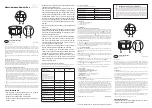
Inverting the Loop Polarity
When the polarity of the feedback is incorrect, the user must invert the loop polarity and this may be accomplished
by several methods. If you are driving a brush-type DC motor, the simplest way is to invert the two motor wires
(typically red and black). For example, switch the M1 and M2 connections going from your amplifier to the motor.
When driving a brushless motor, the polarity reversal may be done with the encoder. If you are using a single-ended
encoder, interchange the signal MA+ and MB+. If, on the other hand, you are using a differential encoder,
interchange only MA+ and MA-. The loop polarity and encoder polarity can also be affected through software with
the MT, and CE commands. For more details on the MT command or the CE command, see the Command
Reference section.
To Invert Polarity using Hall-Commutated brushless motors, invert motor phases B & C, exchange Hall A with Hall
B, and invert encoder polarity as described above.
Sometimes the feedback polarity is correct (the motor does not attempt to run away) but the direction of motion is
reversed with respect to the commanded motion. If this is the case, reverse the motor leads AND the encoder
signals.
If the motor moves in the required direction but stops short of the target, it is most likely due to insufficient torque
output from the motor command signal MCM
n
. This can be alleviated by reducing system friction on the motors.
The instruction:
TTA <return>
Tell torque on A
reports the level of the output signal. It will show a non-zero value that is below the friction level.
Once you have established that you have closed the loop with the correct polarity, you can move on to the
compensation phase (servo system tuning) to adjust the PID filter parameters, KP, KD and KI. It is necessary to
accurately tune your servo system to ensure fidelity of position and minimize motion oscillation as described in the
next section.
Step 8b. Connect Sinusoidal Commutation Motors
When using sinusoidal commutation, the parameters for the commutation must be determined and saved in the
controller’s non-volatile memory. The setup for sinusoidal commutation is different when using Hall Sensors. Each
step which is affected by Hall Sensor Operation is divided into two parts, part 1 and part 2. After connecting
sinusoidal commutation motors, the servos must be tuned as described in Step 9.
Step A.
Disable the motor amplifier
Use the command, MO, to disable the motor amplifiers. For example, MOA will turn the A axis motor off.
Step B.
Connect the motor amplifier to the controller.
The sinusoidal commutation amplifier requires 2 signals, usually denoted as Phase A & Phase B. These
inputs should be connected to the two sinusoidal signals generated by the controller. The first signal is the
axis specified with the command, BA (Step 6). The second signal is associated with the highest analog
command signal available on the controller - note that this axis was made unavailable for standard servo
operation by the command BA.
When more than one axis is configured for sinusoidal commutation, the controller will assign the second
phase to the command output which has been made available through the axes reconfiguration. The 2
nd
phase of the highest sinusoidal commutation axis will be the highest command output and the 2
nd
phase of
the lowest sinusoidal commutation axis will be the lowest command output.
It is not necessary to be concerned with cross-wiring the 1
st
and 2
nd
signals. If this wiring is incorrect, the
setup procedure will alert the user (Step D).
Example: Sinusoidal Commutation Configuration using a DMC-4070
BAAC
Chapter 2 Getting Started
•
21
DMC-40x0 User Manual
Содержание DMC-4040
Страница 17: ...DMC 4080 Layout Figure 2 2 Outline of the of the DMC 4080 DMC 40x0 User Manual Chapter 2 Getting Started 8...
Страница 19: ...DMC 4040 Dimensions Figure 2 5 Dimensions of DMC 4040 DMC 40x0 User Manual Chapter 2 Getting Started 10...
Страница 20: ...DMC 4080 Dimensions Figure 2 6 Dimensions of DMC 4080 Chapter 2 Getting Started 11 DMC 40x0 User Manual...
Страница 54: ...Chapter 3 Connecting Hardware 45 DMC 40x0 User Manual...
Страница 55: ...DMC 40x0 User Manual Chapter 3 Connecting Hardware 46...
Страница 56: ...Chapter 3 Connecting Hardware 47 DMC 40x0 User Manual...
Страница 73: ...Figure 4 1 GalilTools DMC 40x0 User Manual Chapter 4 Software Tools and Communication 64...
Страница 185: ...THIS PAGE LEFT BLANK INTENTIONALLY DMC 40x0 User Manual Chapter 7 Application Programming 176...
Страница 205: ...THIS PAGE LEFT BLANK INTENTIONALLY DMC 40x0 User Manual Chapter 10 Theory of Operation 196...
Страница 220: ...Step 2 Remove ICM For DMC 4040 Proceed to Step 3 Configure Circuit Appendices 211 DMC 40x0 User Manual...
Страница 222: ...Step 2 Remove ICM s Appendices 213 DMC 40x0 User Manual...
Страница 232: ...DMC 4080 Steps 4 and 5 Step 4 Replace ICM s Appendices 223 DMC 40x0 User Manual...
















































